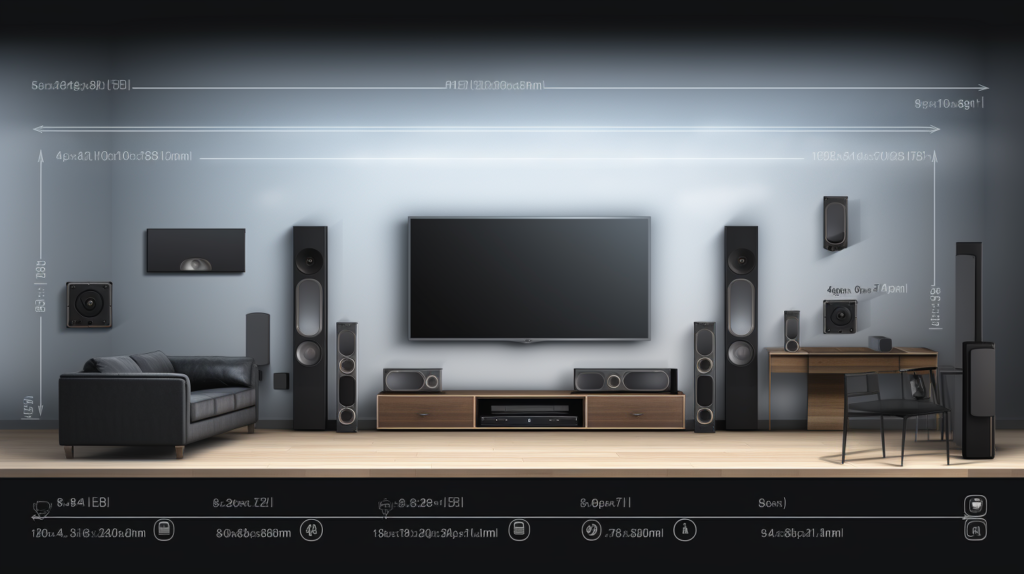Enjoying your favorite movies and shows is just not the same without high-quality audio to draw you into the action.
The good news is you can easily upgrade your TV’s weak built-in speakers with a compact soundbar for room-filling sound.
Choosing the right soundbar can seem overwhelming given the many sizes, features, and connectivity options available today.
But with some key considerations in mind, you can find the perfect audio upgrade to transform your home entertainment experience.
In this comprehensive guide, we’ll walk through the key factors to keep in mind, from setting your budget to optimizing placement and connectivity.
With the right soundbar picked out and properly set up, you’ll finally hear and feel movies, music, and TV shows the way they were meant to be experienced.
Let’s dive in!
Factors to consider when buying a soundbar (budget, room size, TV size, audio needs)

When looking to purchase a soundbar for your home, one of the first factors to consider is your budget.
Soundbars can range greatly in price from inexpensive models around $100 to high-end options over $1000.
Think about the maximum amount you are willing to spend based on your audio needs and room size.
This will help narrow down the choices.
Secondly, take into account the size of the room you plan to use the soundbar in.
Larger spaces require soundbars with higher wattages and multiple speakers to fill the room with sound.
Smaller rooms may only need a basic single-speaker soundbar.
Measure your room size and look for the recommended wattage for that square footage when shopping.
In addition to room size, you’ll want to factor in the size of your television.
One of the benefits of a soundbar is having enhanced audio directly under your TV screen.
So when determining size, choose an option that fits the width of your TV stand or wall mount.
Measure the exact width and find a soundbar that will seamlessly match for the best audio-video integration.
Beyond size considerations, think about your specific audio needs and priorities.
Are you looking for impressive surround sound for watching movies?
Do you need enhanced dialogue to understand TV shows?
Do you want deep bass for listening to music?
This will give you insight into which audio features like Dolby Atmos, number of speakers, and subwoofer connectivity are most important for your purposes.
Soundbar vs. Soundbase vs. Full Home Theater System

There are differences between a soundbar, sound base, and full home theater.
Here are what they are individually:
What Is A Soundbar
The most popular and affordable option is the soundbar. Soundbars are long horizontal speakers designed to boost audio from your TV.
They come in simple single-speaker designs or more robust multi-speaker soundbars with separate subwoofers.
Soundbars produce much better sound than your TV’s built-in speakers.
They are an easy audio upgrade for minimal investment.
What Is A Sound Base?
A sound base is a wider speaker platform designed for your TV to sit directly on top.
The flat wide surface provides stability while angled speakers point up to reflect audio.
Soundbases save space and can produce quality sound, but may lack some audio features of higher-end soundbars.
They work best for smaller TVs.
What Is A Full Home Theater System
For true home theater sound, a full surround sound system with 5 or more speakers plus a subwoofer delivers an immersive audio experience.
While pricier, the multi-speaker placement throughout your room creates detailed cinema-style sound for movies and music. This setup requires more equipment and wiring for installation.
When choosing between these three options, consider your budget, room size, ease of setup, and audio expectations.
Soundbars offer simple enhancements for clearer dialogue and good stereo sound.
Soundbases are compact options for small spaces.
Full theater systems provide premium immersive surround sound if you have the budget.
Evaluate your needs to decide which audio upgrade works best in your home.
Key Features and Audio Technologies to Enhance Your Listening

When researching the latest soundbar models, you’ll come across certain features and audio technologies that can significantly enhance your listening experience.
Understanding these specs will help you choose a soundbar optimized for your needs.
Dolby Atmos
One of the most cutting-edge surround sound formats right now is Dolby Atmos.
This audio technology adds height channels above the listener, allowing sound to come at you from all directions, even above.
The 3D immersive effect puts you inside the action for an incredibly realistic cinematic experience with movies and music.
If you want a premium home theater setup, look for a soundbar advertised as Dolby Atmos compatible.
DTS:X
A comparable surround technology is DTS:X which also delivers multi-dimensional audio through additional channels.
Some soundbars support Dolby Atmos while others offer DTS:X. Both provide engaging, spatial sound that fills your room.
It’s worth researching which movie and music formats each is used for to ensure you get the optimal experience.
Voice Assistant Integration
In terms of usability, many soundbars now integrate voice assistants like Amazon Alexa or Google Assistant.
With built-in mics, you can control music selection, look up information, manage smart home devices, and more completely hands-free.
Voice capability makes soundbars even more convenient and versatile.
EQ Presets
You’ll also see soundbars advertised with varying equalizer or audio presets such as Movies, Music, Sports, etc.
These preset optimize the audio settings based on what type of content you’re listening to.
Having EQ presets makes it easy to get the best sound profile for different media uses.
Taking the time to understand the latest audio formats and smart features will ensure the soundbar you choose takes your home listening to the next level through an immersive, high-tech experience.
Soundbar Power and Connectivity Options

When setting up your soundbar, you’ll need to consider how to best connect it to power and your other devices. Key options to look for include HDMI, optical, Bluetooth, and WiFi.
HDMI Ports
HDMI ports allow you to plug your soundbar directly into your TV’s HDMI ARC input.
This single cable carries both audio signals from the TV and control signals from the soundbar remote.
It’s a convenient way to sync up video and audio while only needing one cord. Soundbars with HDMI inputs also let you connect media players, gaming systems, and more.
Optical Audio
An optical audio connection is another common way to hook up a soundbar.
Optical cables transmit digital audio signals between the TV and speaker for high-quality sound.
The only downside is it limits control compared to HDMI ARC. But optical cables neatly carry audio if your TV doesn’t have ARC.
Bluetooth
For wireless music streaming, Bluetooth is extremely useful. It lets you pair your smartphone, tablet, or laptop to the soundbar to play podcasts, playlists, and other audio content wirelessly from apps and services.
The Bluetooth range can vary between models, so check it will cover your room size.
WiFi Connectivity
WiFi connectivity opens up smart soundbar capabilities.
With WiFi built-in, you can access online music libraries, use casting features, control playback from apps, get wireless software updates, and enable multi-room audio. WiFi vastly expands what you can do.
Carefully considering these wired and wireless connection types will ensure seamless integration of your soundbar for the best user experience.
Enhancing Your Soundbar with Subwoofers and Rear Speakers

While soundbars provide a big audio upgrade over your TV’s built-in speakers, you can take your sound to the next level by adding a subwoofer and rear speakers.
Wireless Subwoofer
A wireless or wired subwoofer pair with your soundbar to handle the low bass frequencies. This adds powerful punch and depth to action movies and thumping music.
Look for a soundbar that has a subwoofer output if deep bass is important to you.
Rear Surround Speakers
Rear speakers, either wireless or wired, create true surround sound for an immersive experience.
Placement behind your seating position makes it sound like audio is coming at you from every direction.
Rear speakers combined with a sub and soundbar complete your home theater setup.
Soundbar Kits
Some higher-end soundbars come with wireless subwoofer and satellite speaker kits included.
This gives you expansive surround sound from one package without running wires. Or you can buy separate components to integrate with your existing soundbar.
Expanding Your System
If you are willing to install multiple speakers and invest in the additional equipment, the payoff is incredible, room-filling audio ideal for movies, sports, and videogames.
Just make sure your chosen soundbar is compatible with add-on components to build your optimal sound system over time.
Optimizing Soundbar Placement and Mounting in Your Space

One of the biggest factors in getting the best performance from your soundbar is proper placement and mounting.
Take time to consider the ideal positioning based on your room layout, seating, and TV setup.
Below Wall-Mounted TV
The most common placement is directly below your wall-mounted TV or centered under a TV stand.
This alignment of video and audio from the same general location creates a seamless viewing experience. Measure the width of your TV stand or mount to find a soundbar that fits perfectly.
Standalone Placement
For open-concept rooms, you may want a standalone soundbar placed away from the TV wall.
The speakers can angle out towards the seating area rather than just straight ahead. This spreads the soundstage wider. Just make sure the TV is connected to the soundbar.
Room Acoustics
Room acoustics impact sound as well. Hardwood floors and bare walls can cause echo and muffling.
Large rugs and wall hangings help absorb sound for clearer audio. Place your soundbar clear of furniture blocks and room dividers.
Most soundbars come with rubber feet or wall mounting brackets. Elevated cabinet placement can enhance bass response.
Mounting Options
Wall mounting near ear level gives the best clarity. Trying different heights may be needed to optimize sound.
Taking the time to find the ideal soundbar position for your living space results in a home theater experience that impresses both visually and acoustically.
Proper placement transforms how you enjoy movies, sports, music, and more.
Conclusion
Choosing the right soundbar to boost your TV’s audio does not have to be a difficult process.
By factoring in your budget, room size, TV setup, audio needs, and desired features, you can narrow down the selection to find the perfect model.
Optimize placement and connectivity for seamless integration.
And consider expanding with add-ons like a subwoofer and rear speakers over time as your home entertainment needs to evolve.
With this advice in mind, you’ll be equipped to select a soundbar that dramatically improves your movie-watching, music-listening, and overall TV experience through clearer, richer, and more immersive sound.
